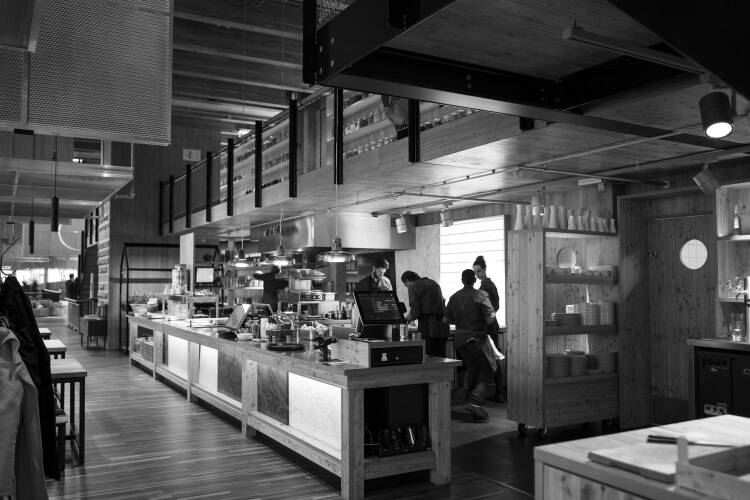© Chowbotics
© Healthfoodwall
Summing up
With the new normal slowly taking shape in the form of hybrid work schedules, traditional workplace catering needs to shift to changing demands. With fewer people in the office at any time, companies may be looking to save space, and employees are looking for more informal, flexible food options. Food connects, and in a world haltingly moving post-pandemic, that connection is more important than ever. At the same time we’ve grown used to the comforts of home. Companies that can best translate those comforts to their food offerings are set up to succeed in a post-pandemic workplace.

Is this what the break room in an office might look like? Healthy food options with a minimum of formal fuss.
compact
The future of food at work is compact. Sprawling open cafeterias and chef driven restaurants are becoming more difficult to justify in a hybrid work culture where employees divide their time between working from home and working at the office. When the number of people in the office can vary greatly day to day, purchasing and food waste become major challenges. The same shift in culture can turn space into a premium commodity. Look for the emergence of micro markets and contactless breakrooms, with the aforementioned shift towards healthier options. Automation is another big frontier in compact food solutions for workspaces. While many advances in robotics seem aimed towards the broader foodservice market, the self-contained robotic kiosks could easily find their way into office spaces.

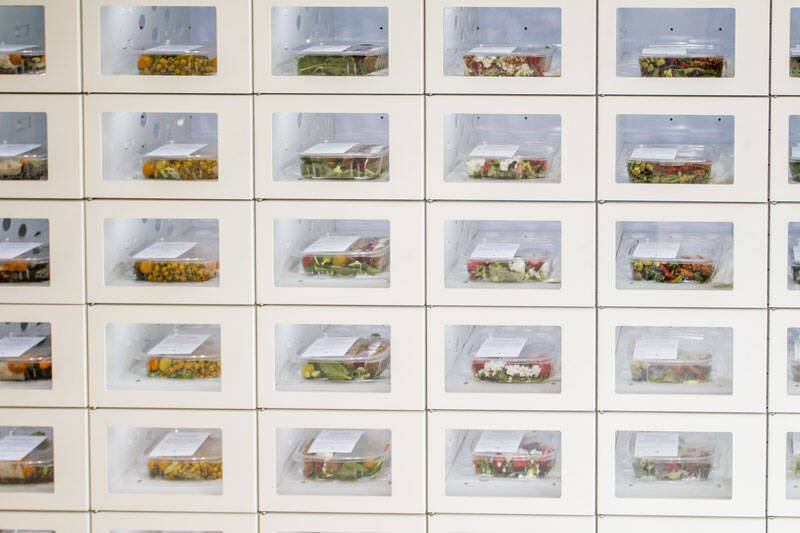
food robots
- Sally the salad making robot by Chowbotics is one of the more famous examples of an automated healthy food option.
- German startup DaVinci Kitchen recently raised over half a million in equity crowdfunding for their self-contained pasta making kiosk, that measures only 2.1m wide by 2.5m high and 2.4m long.
- Product development incubator / venture capital fund Wavemaker Labs has several robotic options in their portfolio, including Piestro the robotic pizzeria, and Bobacino the automated bubble tea bar.


Ready for robotic assembly, quality ingredients are even more important without the chef’s touch to make for delicious dishes.

Delivery and digital
Meal delivery has taken our homes by storm, and it’s coming for our office too. And that’s not a bad thing. For one, it’s another enormous space saver. Second, it allows for a variety that is almost impossible to provide yourself. Companies like Sweetgreen have been pioneering their outposts - essentially just a fixed delivery point inside an office - for a few years now, and similar models are popping up in multiple places. Another interesting idea is something like Cloud Cafe by ZeroCater. They’ve turned the company cafe into a digital marketplace, with access to hundreds of restaurants and caterers operating out of central commissaries. They’re using AI applications to curate a personalized menu for employees, so choosing out of the tens of thousands available food items is actually doable. Using the service, the company can choose to pay for all or part of its employee meals through the platform. That’s a lot easier to manage than just opening the door for Uber Eats delivery drivers, for example.

flexible spaces
Rigid cafeterias or corporate restaurants are no longer the thing to strive for. Instead cafeteria spaces can become more flexible, especially if a company has embraced working remotely and has fewer people in the office on any given day. The keyword is informal. We’ve been having lunch at our home desk, or working at the dinner table for a long time, and many people have found this flexible, informal space to their liking. This cultural shift leaves room for win-win situations. Companies can save valuable square footage turning a cafeteria into a space for informal meetings, and replace a large central kitchen with compact solutions. Alternatively, consider creating multiple smaller break rooms with a small selection of fresh food or high-tech salad making robots. After a year in relative isolation, the opportunity to connect with coworkers face to face over a shared experience is what’s most valuable here.
Better food
A standard issue vending machine filled with old fashioned snacks was already outdated before this whole pandemic business. But with a year and half filled with mental and physical health challenges behind us, the cry for healthier options has become deafening. While companies don’t quite need to embrace the food as medicine extremes, functional foods with proven health benefits and excellent flavors are shooting up the list. Fresh fruit and vegetables, seasonal salads, probiotics: healthy food is the new normal.
Circular restaurant Circl in Amsterdam is an example of a new wave of chef-driven restaurants doubling as workplace catering. Sustainability is at the heart of it. With a strong philosophy and excellent food, there is a place for these kinds of ventures.
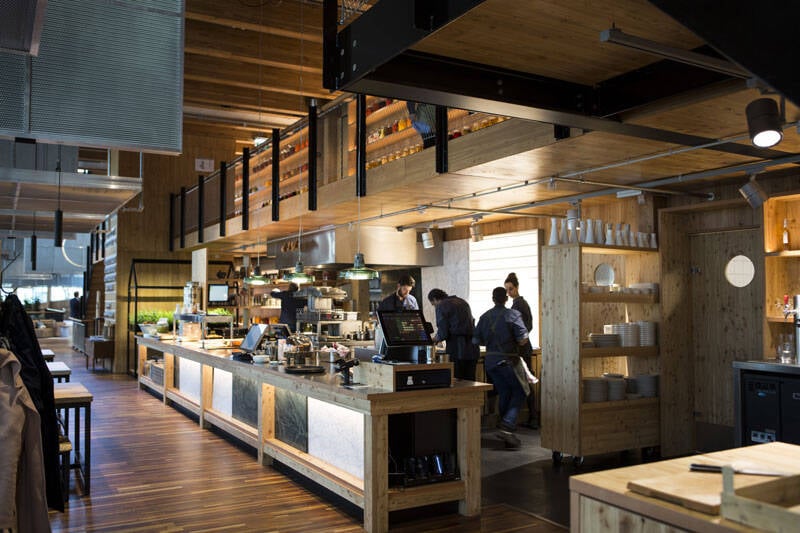
The coronavirus and its new variants are making for a return to work that is challenging, uneven, and perhaps fraught. It’s looking to be a long while before the world can truly say it is ready to return to normal, whatever that looks like. Still, as people are returning to the office, companies are finding that the expectations of workplace catering have shifted. Our wants and needs have changed. What does the future of food in the workplace look like?
Jelle Steenbergen Xiao Er Kong
The future of compact food at work
Functional food in flexible spaces
trendwatch


4 min
the future of compact food at work
© Chowbotics
Summing up
With the new normal slowly taking shape in the form of hybrid work schedules, traditional workplace catering needs to shift to changing demands. With fewer people in the office at any time, companies may be looking to save space, and employees are looking for more informal, flexible food options. Food connects, and in a world haltingly moving post-pandemic, that connection is more important than ever. At the same time we’ve grown used to the comforts of home. Companies that can best translate those comforts to their food offerings are set up to succeed in a post-pandemic workplace.

Ready for robotic assembly, quality ingredients are even more important without the chef’s touch to make for delicious dishes.
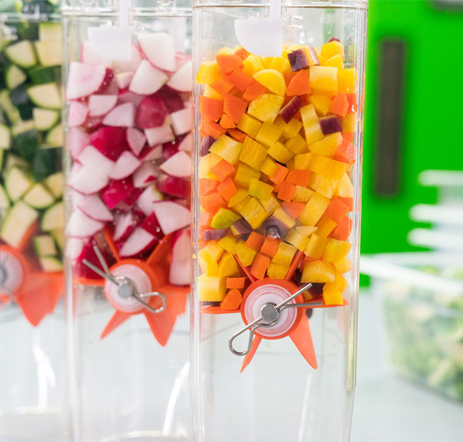
food robots
- Sally the salad making robot by Chowbotics is one of the more famous examples of an automated healthy food option.
- German startup DaVinci Kitchen recently raised over half a million in equity crowdfunding for their self-contained pasta making kiosk, that measures only 2.1m wide by 2.5m high and 2.4m long.
- Product development incubator / venture capital fund Wavemaker Labs has several robotic options in their portfolio, including Piestro the robotic pizzeria, and Bobacino the automated bubble tea bar.

© Healthfoodwall
Is this what the break room in an office might look like? Healthy food options with a minimum of formal fuss.
compact
The future of food at work is compact. Sprawling open cafeterias and chef driven restaurants are becoming more difficult to justify in a hybrid work culture where employees divide their time between working from home and working at the office. When the number of people in the office can vary greatly day to day, purchasing and food waste become major challenges. The same shift in culture can turn space into a premium commodity. Look for the emergence of micro markets and contactless breakrooms, with the aforementioned shift towards healthier options. Automation is another big frontier in compact food solutions for workspaces. While many advances in robotics seem aimed towards the broader foodservice market, the self-contained robotic kiosks could easily find their way into office spaces.

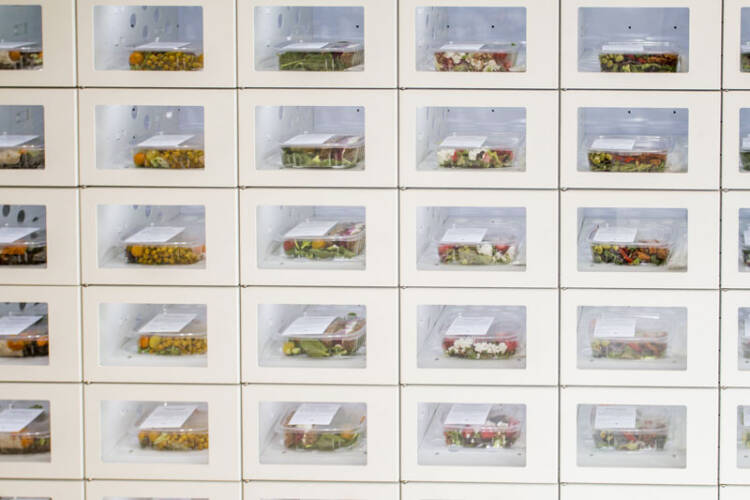

Delivery and digital
Meal delivery has taken our homes by storm, and it’s coming for our office too. And that’s not a bad thing. For one, it’s another enormous space saver. Second, it allows for a variety that is almost impossible to provide yourself. Companies like Sweetgreen have been pioneering their outposts - essentially just a fixed delivery point inside an office - for a few years now, and similar models are popping up in multiple places. Another interesting idea is something like Cloud Cafe by ZeroCater. They’ve turned the company cafe into a digital marketplace, with access to hundreds of restaurants and caterers operating out of central commissaries. They’re using AI applications to curate a personalized menu for employees, so choosing out of the tens of thousands available food items is actually doable. Using the service, the company can choose to pay for all or part of its employee meals through the platform. That’s a lot easier to manage than just opening the door for Uber Eats delivery drivers, for example.

flexible spaces
Rigid cafeterias or corporate restaurants are no longer the thing to strive for. Instead cafeteria spaces can become more flexible, especially if a company has embraced working remotely and has fewer people in the office on any given day. The keyword is informal. We’ve been having lunch at our home desk, or working at the dinner table for a long time, and many people have found this flexible, informal space to their liking. This cultural shift leaves room for win-win situations. Companies can save valuable square footage turning a cafeteria into a space for informal meetings, and replace a large central kitchen with compact solutions. Alternatively, consider creating multiple smaller break rooms with a small selection of fresh food or high-tech salad making robots. After a year in relative isolation, the opportunity to connect with coworkers face to face over a shared experience is what’s most valuable here.
Better food
A standard issue vending machine filled with old fashioned snacks was already outdated before this whole pandemic business. But with a year and half filled with mental and physical health challenges behind us, the cry for healthier options has become deafening. While companies don’t quite need to embrace the food as medicine extremes, functional foods with proven health benefits and excellent flavors are shooting up the list. Fresh fruit and vegetables, seasonal salads, probiotics: healthy food is the new normal.
Circular restaurant Circl in Amsterdam is an example of a new wave of chef-driven restaurants doubling as workplace catering. Sustainability is at the heart of it. With a strong philosophy and excellent food, there is a place for these kinds of ventures.

The coronavirus and its new variants are making for a return to work that is challenging, uneven, and perhaps fraught. It’s looking to be a long while before the world can truly say it is ready to return to normal, whatever that looks like. Still, as people are returning to the office, companies are finding that the expectations of workplace catering have shifted. Our wants and needs have changed. What does the future of food in the workplace look like?
Jelle Steenbergen Xiao Er Kong
Functional food in flexible spaces
The future of compact food at work
4 min
